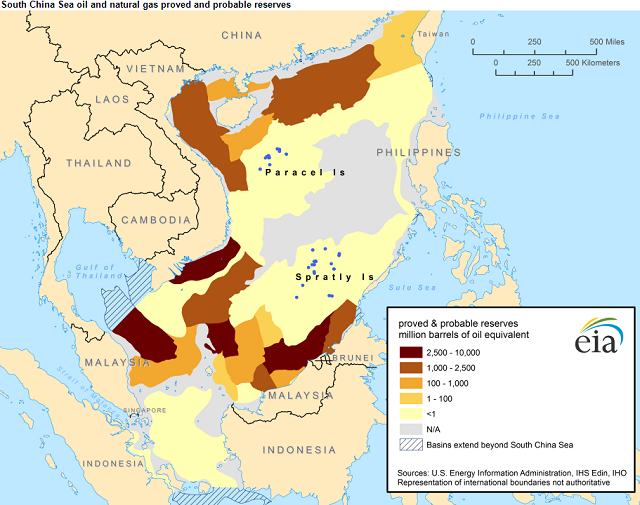China, Vietnam Consider Joint Offshore Development
China and Vietnam agreed to friendly negotiations, and the possibility of joint development projects, to settle their differences over the resource rich South China Sea.
A joint communique carried by Xinhua said that both countries had a candid exchange of views on their maritime differences when China's president and the head of Vietnam's Communist Party met this week.
The leaders stated that they would “proactively look for transitional resolution methods which do not affect either side's position, including looking at and discussing joint development”.
Communist parties rule both countries, and trade has swelled to $50 billion annually, but Vietnam has long been suspicious of its giant neighbor, especially over Beijing's increasingly assertive claims to almost the entire South China Sea.
Anti-Chinese violence flared in Vietnam last year after a $1-billion deepwater rig owned by CNOOC was parked 240 km (150 miles) off the coast of Vietnam in the South China Sea.
Since then, however, China has sought to make amends with Vietnam, including sending senior officials to Hanoi.
Chinese President Xi Jinping told Nguyen Phu Trong, general secretary of Vietnam's Communist Party, on Tuesday that the two countries must manage their dispute over the South China Sea well to maintain peace and stability.
Joint Development Successes
Joint developments have been achieved successfully elsewhere including the 1979 Memorandum of Understanding and the 1990 agreement between Malaysia and Thailand which led to joint developments in disputed waters in the Gulf of Thailand.
The Timor Gap Treaty, signed by Australia and Indonesia in 1989, and the Treaty on Certain Maritime Arrangements in the Timor Sea, signed by Australia and East Timor in 2006, also facilitated joint development in disputed waters.
China’s Need
China’s remarkable economic growth over the past three decades is matched by an insatiable thirst for oil, states analyst John R. Weinberger in China Seeks to Dominate Off-Shore Energy Resources in the South and East China Seas.
China’s average annual growth in crude oil consumption has been 7.4 percent over the past ten years. By 2020, the CNPC Economic and Technology Research Institute projects that 65 percent of Chinese crude oil supplies will be imported.
Natural gas is quickly emerging as a primary alternative fuel in China for electric power generation and transportation, says Weinberger. The Institute of Energy Economics of Japan’s projection, through the year 2040, forecasts a steep 42 percent rise in China’s natural gas consumption from 2011.
Offshore developments
Most development of offshore resources to date has occurred close to shore within each country’s exclusive economic zone. CNOOC is the most active of China’s national oil companies in the South China Sea and is working with Husky on the Liwan gas field that has an estimated 4-6 trillion cubic feet in proved and probable reserves.
China more than tripled natural gas production since 2003, producing 3.8 trillion cubic feet (Tcf) in 2012, and the government is targeting production to reach about 5.5 Tcf of natural gas per year by the end of 2015. Most of the anticipated production growth is from large onshore fields in the western and north central regions of China as well as from the offshore deepwater regions in the South China Sea.
PetroVietnam has partnered with a number of foreign companies to develop offshore fields. Because of the government's push to award foreign contracts, major foreign oil companies have a strong presence in Vietnam's offshore production in production-sharing contracts (PSCs) with PetroVietnam.
Chevron has operated offshore Vietnam since 1996 and expanded its operations after acquiring Unocal in 2005. The company currently operates three PSCs in the Cuu Long and Phu Khanh Basins and estimates around 5 Tcf in proved and probable reserves offshore Vietnam. French independent Perenco surpassed ConocoPhillips as the largest energy investor in Vietnam in 2012 after buying out the U.S. company's Vietnam assets, including six offshore blocks in the South China Sea.
Future Potential
The U.S. Energy Information Administration (EIA) estimates for the area stretching from Singapore and the Strait of Malacca to the Strait of Taiwan is approximately 11 billion barrels of oil and 190 trillion cubic feet of gas in proved and probable reserves. Most conventional hydrocarbons reside in undisputed territory.
However, EIA admits that it is difficult to make an accurate estimate because of under-exploration and territorial disputes. The contested Spratley Islands have virtually no proved or probable oil reserves and industry sources suggest less than 100 billion cubic feet of gas. However, a US Geological Survey 2010 analysis resulted in an estimate of 0.8 and 5.4 billion barrels of oil and between 7.6 and 55.1 trillion cubic feet of gas in undiscovered resources.
The contested Paracel Islands do not have significant discovered conventional oil and gas fields, and geological evidence suggests the area does not have significant potential. However, the area may contain significant natural gas hydrate resources.
Territorial claims
China claims about 90 percent of the South China Sea, displaying its reach on official maps with a so-called nine-dash line that stretches deep into the maritime heart of Southeast Asia.
China refers to the Spratly Islands, Paracel Islands, Pratas Island, and Scarborough Reef as Nansha Qundao, Xisha Qundao, Dongsha Qundao, and Huangyan Dao, respectively, claiming these as well as all surfacing and undersea features within the nine-dashed line.
Vietnam claims all of the Spratly and Paracel Islands. Vietnam considers the Spratly Islands an offshore district of Khanh Hoa Province and occupies several of them.
China seized all of the Paracels in 1974. Like the Chinese, Vietnamese archeologists provide their own evidence to support a long historic presence. Hanoi claims that since France controlled both island groups beginning in the 1930s, Vietnam succeeded to those rights after independence.
The Philippines, Malaysia, Brunei and Taiwan also have claims to parts of the potentially energy-rich waters that are crossed by key global shipping lanes.

